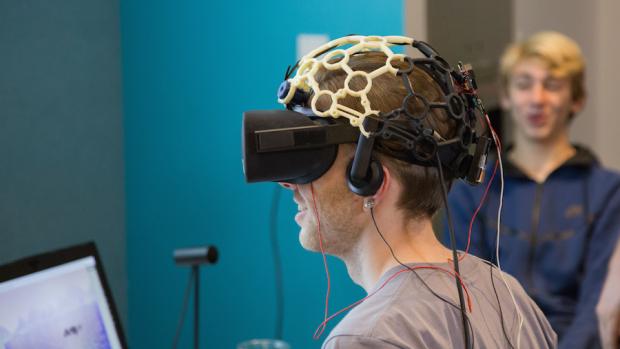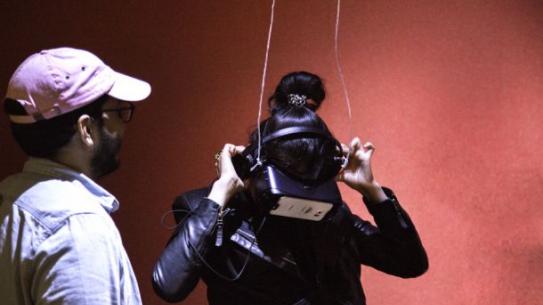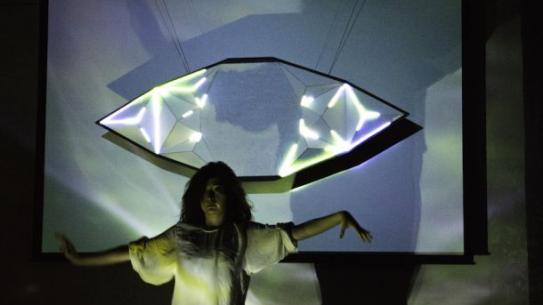Merging the human experience with technology at the 2017 Integrated Digital Media Showcase

Immersive mixed reality experience "WAVR"
Reimagining how we experience the world through technology, over 100 student-produced projects at the 2017 Integrated Digital Media (IDM) Spring Showcase explored the intersections of being human, art, storytelling, nature, identity, community and technology. Exhibiting their boundary-pushing ideas and designs, students engaged with mediums ranging from dance, performance, installation, print, film, virtual reality (VR), augmented reality (AR), and mixed reality (MR).
“AR and VR are extremely popular in the market right now,” assistant professor and IDM Showcase organizer Katherine Bennett noted about the many VR and AR projects. “Our faculty and students are active at new intersections of development. It’s no surprise that our students incorporate them into their practice, using these mediums to relay their messages, ideas and stories. It’s exciting to see how they reshape and develop a medium even further.”
As visitors navigated through the innovative and interactive projects at the NYU Media and Games Network (MAGNET), it was easy to see the students’ passion for technology and design. Maxine Kho, an undergraduate student and one of the IDM Showcase committee members, expressed that “behind every project and show lies not only hard word and skill, but more importantly heart. The passion that the IDM community brings people together with is infectious.”
The Projects
Exploring the abilities of mind power through virtual reality, graduate students Baris Siniksaran (Integrated Digital Media) and Sean Kim (Interactive Telecommunications Program) developed the immersive mixed reality experience WAVR, in which neuro-controlled VR technology uses biosensors to monitor increases in alpha waves (brain waves that increase as a person enters a meditative state). The brainwave data triggers commands on the VR application, allowing the user to control virtual objects with their mind. In addition to virtual reality, WAVR engages other physical senses through a vibrating chair, a fan blowing cool air, and wafts of perfume. “We want to see how much the human brain is capable of doing with the help of VR,” Siniksaran said, adding that WAVR aims to help people focus and increase productivity.
Experimenting with Microsoft’s mixed reality technology HoloLens, members of Technology, Culture and Society lecturer Dana Karwas’ User Experience Design course were challenged to create a mixed reality environment that developed unique and interactive experiences with artwork. The three projects — HelloLens, Holograil, and Hologlass — all explore how technology reinvents how we interact with art. Tyler Mechura described the HelloLens project as reimagining the artist studio visit, where paintings, installations, sculptures and video appear as interactive holograms and a digital assistant shares information about the artist and their artwork.
Tatiana Pilon, a graduate student in IDM, shared her thesis project “ANA: An immersive journey to redemption,” a virtual reality embodiment that attempts to bridge the empathy gap between a viewer and diverse characters, and hopefully combat the stereotypes minority groups face when represented in media. “In this virtual reality world, the user is encountering someone different from themselves,” Pilon said. Pilon will be presenting ANA at the upcoming Creative Tech Week, and will also discuss diversity in animation.

Dozens of visitors lined up to experience “Peer,” a virtual reality short film created and produced by IDM graduate student Emir Fils-Aime that tells the story of a young black man as he wrestles with cynicism about his identity. Once users donned the VR headset, they inhabited the main character’s mind as he walks through a forest, with real leaves — strewn across the floor — crunching beneath their feet. Fils-Aime noted that “Peer” is the first installment in a trilogy of virtual reality short films that explore identity through immersive storytelling.
Multiple projects revolved around what happens when common materials and knowledge are transformed anew through virtual reality and augmented reality. Inspired by the book and television series Game of Thrones, Vhalerie Lee and Subigya Basnet created a mobile augmented reality experience that transports anyone into the fictional world. Through the mobile application, users hold up the phone’s camera to a physical map of Westeros, where they can navigate 3D castles and trigger castle history by tapping 3D sigils. “We wanted to experiment with different ways to use AR,” Basnet said. Lee also exhibited her immersive virtual reality film “Big Brother is watching,” loosely based on George Orwell’s novel 1984 and created using Unreal Engine and Maya for the Oculus Rift headset.
Mayukh Goswami, a first year IDM graduate student, presented his two augmented reality projects, “The Lenore Project” and “Modernity.” Goswami’s design brings printed text and images to life through a mobile augmented reality application. With the scan of a smartphone’s camera, birds suddenly fly across magazine covers of The New Yorker. In “The Lenore Project,” Goswami created a fictional small town newspaper that allows a reader’s smartphone to transform 2D pictures into fantastical moving images.

The evening also featured a live dance performance produced by first year IDM graduate students Mateo Hernandez, Yi-Chih Angela Wang, Sara Camnasio, and Goswami. In “Land On Mirrors,” the dancers disrupted and changed the projected digital landscape through their movements. In the final act, the group encouraged audience participation with smartphone flashlights illuminating patterned plastic sheets to create colorful backdrops for the dancers.
“Our students have a strong foundation in technology, engineering, computer science and design, which comes together in an exciting fusion. It allows our students to dream big and gives them the tools to reach those dreams,” Bennett said.
Camila Ryder
Graduate School of Arts and Science
Master of Arts in English Literature, Class of 2018




